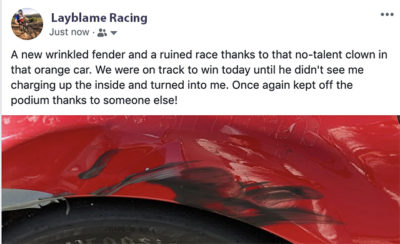Promoting your racing success through social media is essential, but there are things that can be more harmful than good
The internet never forgets, making the old adage of “any publicity is good publicity” no longer applicable. Since mastering the art of social media in an age with increasingly judgmental audiences where every post or tweet has a permanent life has its challenges, here are a few things you should not say or do on social media, or when there’s a camera pointed at you.
• Going Negative
Efrain Olivares, the Motorsports PR representative for Mazda North American Operations, says that drivers posting a video relaying how, in their opinion, they were taken out of a race maybe fine for a pro who is expected to report on each event, but for the club racer or rookie pro, those comments can bite.
“There’s an expectation that if you’re competing in club racing that your goal is to have fun,” he says. “So, I don’t think that consistently airing your grievances leads people to think you’re the kind of racer they may someday want to hire. The rules change slightly when you’ve achieved a certain level of success and you’re a paid professional – in those cases, if you’ve had a bad weekend, you’re within your rights to explain why but even in that situation you are walking a fine line.”
The same is true for criticizing others, and that applies doubly if that someone is a sponsor, supporting manufacturer, or other advocate. Complaining about your engine not having power or a broken part when the manufacturer is among your supporters is not going to encourage others to come on board with you.
“Even if Mazda isn’t cutting you a check directly, you’re still representing the brand and should always consider that when you are on social media, interacting with the media, or frankly even in peer to peer conversations,” says Matt Cleary, whose Sunday Group Management provides public relations services for Battery Tender Mazda MX-5 Cup presented by BFGoodrich. “Look at all the brands in your paddock, from contingency sponsors to track title sponsors. You want to not only be attractive to them, but more importantly-you don’t want to be unattractive to them!”
• Lack of Professionalism
With modern technology, there’s no excuse to have misspellings or bad grammar in a newsletter, blog post, or social media post. Use spell check and proofread to make sure you sound like a cogent, intelligent person in your communication. “Not everyone is a communications specialist, but everyone does have access to the tools to make sure your posts meet a minimum standard of correctness,” says Cleary.
• Timeliness, or Lack Thereof
The chances that anyone cares to read “news” about a race that happened three months ago are slim. Why are you just now writing a post about it?
• Divisive Topics
You’re not going to change anyone’s mind with a political post, but you sure could irritate followers, perhaps even to the point of them unfollowing you. Divisive topics are exactly that, and for every follower who agrees with you on that hot-button topic, there’s one who doesn’t. One answer might be to have a personal social media account and another one for you, the race car driver. Just know that if you do, it’s not that hard for someone to find your personal account if they’re following your professional online persona. Of course, you still want to remain authentic to yourself and if there’s a topic or an issue that you feel strongly about, you should speak to it – just speak to it in a measured, respectful way and understand you may receive some negative responses.
• Being Boring
As you’re trying to avoid these pitfalls, it’s possible to go the other way. “You can play it too safe and make yourself a boring caricature of a race car driver,” Olivares points out. The same applies to interviews. If all you can say is, “The Sponsor A / Sponsor B / ABC Tire Mazda MX-5 ran great today,” then chances are the interviewer isn’t going to be seeking you out in the future.
All of this should illustrate that there’s a fine line between irritating readers and followers, and being the sort of driver people want to follow. And if you have a strategy, walking that line becomes much easier.


 ACCESSIBILITY
ACCESSIBILITY